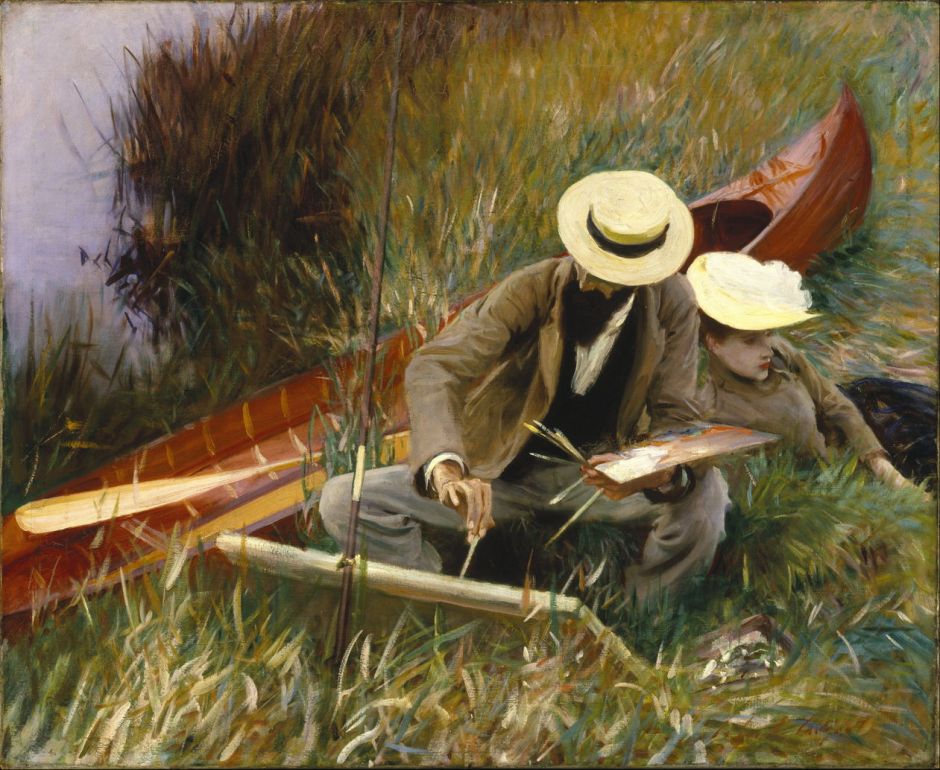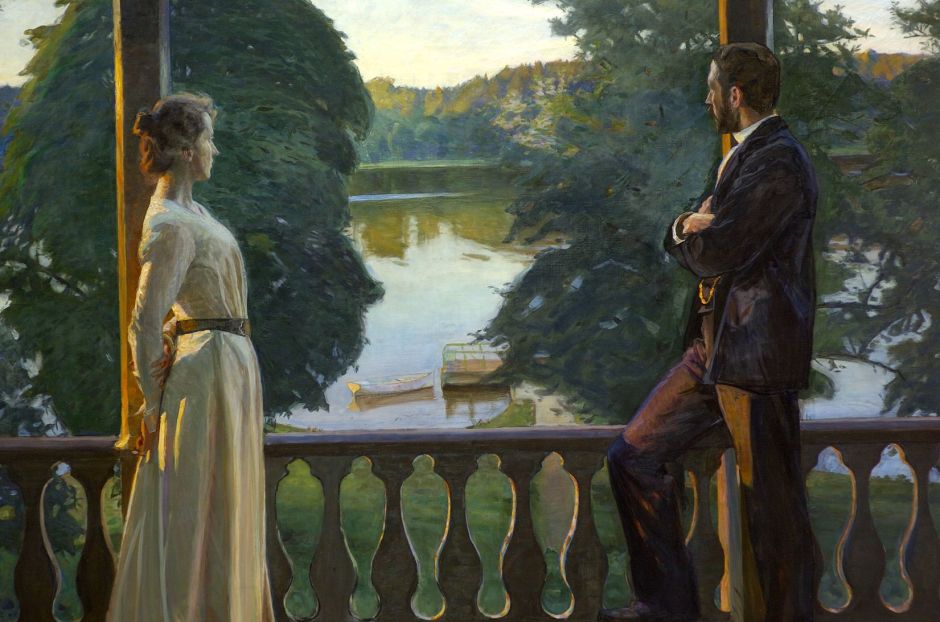On 22 August, I’ll be commemorating the centenary of the death of one of the early twentieth century’s master painters, Anders Zorn (1860-1920). He was one of three masters who took realist oil painting from the late nineteenth century into the twentieth, three virtuosi who rank among the greatest visual artists of Europe: the American John Singer Sargent (1856–1925), the Spaniard Joaquín Sorolla (1863–1923), and Zorn, who was Swedish by birth but worked much of his late career in the US.

John Singer Sargent should need no introduction. Trained in Paris with Carolus-Duran, he established a highly successful portraiture business which he moved to London. His wonderfully loose oil paintings and watercolours were like daily exercise, with seemingly effortless genius.


Sorolla established his reputation with a series of brilliant Naturalist paintings of fishermen and their boats on the beach at Valencia, and a range of other more narrative themes. He had the reputation of painting voraciously, often using brushes with extremely long handles and large canvases.
Sewing the Sail from 1896 shows a scene on a patio at El Cabañal beach, Valencia, during the Sorolla family holiday in the summer of that year. Although it may look a spontaneous study of the effects of dappled light, Sorolla composed this carefully with the aid of at least two drawings and a sketch, which survive. It shows the whole family engaged in one of the more technically-challenging supporting tasks ashore.
For the modern oil painter working in fairly realist style these three – Sargent, Sorolla and Zorn – are as idols.
But a Swedish master? Isn’t that unusual if not unique? Actually not: at the time there were many important painters in the Nordic countries, and Sweden was very much included. Perhaps the best-known today is Carl Larsson (1853–1919), born in slums in the capital city of Stockholm. Like other Nordic artists of the time, he spent several years painting in France where he developed an Impressionist style.

Larsson met his wife, the artist Karin Bergöö, in the artists’ colony at Grez-sur-Loing, which was popular among Nordic painters at the time. In 1884, a year after they married, the Larssons had their first child, shown in this intimate pastel double-portrait of A Studio Idyll. The Artist’s Wife and their Daughter Suzanne from 1885. Mother and child are sitting in Larssen’s studio. A talented artist in her own right, after their wedding, Karin Larsson concentrated on interior design, and was responsible for most of the household interiors shown in Larsson’s later work.

Larsson became famous and commercially successful with his watercolours of the Larsson family at home, published in a series of books which remained best-sellers well into the twentieth century. Typical of this published work is the richly detailed Catching Crayfish (1897), which was featured in his book A Home two years later. This is the perfect summer idyll, an aspiration for the many who bought his books.

Richard Bergh is little-known outside Sweden today, but trained at the Royal Swedish Academy of Arts in Stockholm and in France, where he joined the colony at Grez-sur-Loing to paint in the footsteps of Jules Bastien-Lepage. His Nordic Summer’s Evening (1899-1900) features two distinguished models, Prince Eugen, Duke of Närke, and the singer Karin Pyk, who were both close friends of the artist. In fact, it’s a wonderful composite: the pillars shown were borrowed from the floor below, where they supported this balcony, and Pyk was actually painted when she was in Assisi in Italy.
Two other Swedish painters who worked in France for some years were the affluent Eva Bonnier (1857–1909) and her friend Hanna Pauli (1864-1940).

Bonnier’s View from the Studio Door (1885) uses the repoussoir of the studio door to frame the wonderful light of the flowers and garden outside. I wonder if the figure here is that of Hanna Hirsch?

Her Midsummer (1900) uses quite a different light, the magical twilight of the middle of a Nordic midsummer night. Bonnier lights memories of the past, perhaps: a young girl resting on the ground to listen to the music of a violin, or, when older, dancing on the grass.
At about that time, Bonnier seems to have stopped painting, apparently devoting her time to philanthropy. She started a foundation – still active today – to make Stockholm a more beautiful and culturally-rich city. In its early years, it provided funds for the purchase of works of art for schools and public institutions. Tragically, Bonnier took her own life during a bout of depression in 1909.

Hanna Hirsch’s Breakfast-Time (1887) is a dazzlingly virtuoso painting, showing a maid preparing a breakfast table in a garden. It strikes a wonderful balance between the painterliness of the ground and wooden furniture, and sufficient detail to bring the silverware, porcelain and glass to life. Unfortunately, after her marriage to the Swedish painter Georg Pauli (1855-1935), she too seems to have painted very infrequently.
Still internationally famous today is one of the pioneers of wildlife painting, Bruno Liljefors (1860–1939), who was born in the same year as Anders Zorn, in the eastern Swedish city of Uppsala. He wasn’t as precocious as Zorn, and trained at the Royal Swedish Academy of Arts in Stockholm slightly later. As many Nordic painters at the time, he went from there to complete his training in Dusseldorf, Germany.

Some of Liljefors’ finest paintings are almost pure landscapes, such as his Hunting Geese from 1896, with its superb mackerel sky.
The most avant garde artist in the Nordic countries at this time was the Norwegian Edvard Munch (1863–1944). Although I’m not aware of any Swedish painter who was quite as radical as him, there were others at the leading edge, including Eugène Jansson (1862–1915).

Jansson too trained at the Royal Swedish Academy of Arts in Stockholm, but his family couldn’t afford to support him travelling overseas. So he developed his unique ‘symbolist’ style and specialised in these amazing views over the capital city.
One of his finest nocturnes is this seemingly infinite view from his studio on Mariaberget over Riddarfjärden, Stockholm, painted in 1898. As the last (or first) light of the day fades to pale red above the horizon, the waterfront of the old city is lit in white. In the foreground, the gaslights of the quay below form into small whirlpools of light.
Jansson became known as the Blue Painter, although friends and other artists referred to him as Paraffin Jansson, as the light in his paintings reminded them of that from paraffin (kerosene) lamps, still widely used in houses at the time.
I hope this article has provided some context for the series which I will start next week, examining the paintings, other visual art and career of Anders Zorn, one of the three great masters who took realist oil painting into the twentieth century.

